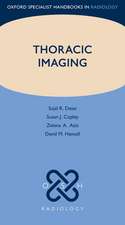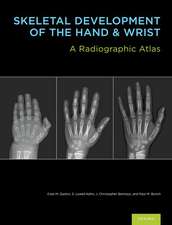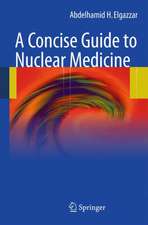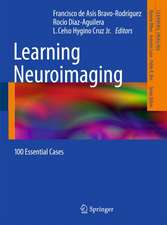Biostatistics for Radiologists: Planning, Performing, and Writing a Radiologic Study
Autor Francesco Sardanelli, Giovanni Di Leoen Limba Engleză Paperback – 28 noi 2008
Preț: 379.33 lei
Preț vechi: 399.29 lei
-5% Nou
Puncte Express: 569
Preț estimativ în valută:
72.58€ • 75.78$ • 60.07£
72.58€ • 75.78$ • 60.07£
Carte tipărită la comandă
Livrare economică 04-18 aprilie
Preluare comenzi: 021 569.72.76
Specificații
ISBN-13: 9788847011328
ISBN-10: 8847011329
Pagini: 231
Ilustrații: XXII, 231 p.
Dimensiuni: 178 x 254 x 16 mm
Greutate: 0.68 kg
Ediția:2009
Editura: Springer
Colecția Springer
Locul publicării:Milano, Italy
ISBN-10: 8847011329
Pagini: 231
Ilustrații: XXII, 231 p.
Dimensiuni: 178 x 254 x 16 mm
Greutate: 0.68 kg
Ediția:2009
Editura: Springer
Colecția Springer
Locul publicării:Milano, Italy
Public țintă
Professional/practitionerCuprins
Introduction.-1 Diagnostic Performance.- 1.1. The Results of an Examination Compared to a Reference Standard.- 1.2 Measures of Diagnostic Performance.- 1.3 Sensitivity, Specificity, FN Rate and FP Rate.- 1.4 Predictive Values, Diagnostic Accuracy, and Disease Prevalence.- 1.5 Bayes’ Theorem, Likelihood Ratios, and Graphs of Conditional Probability.- 1.6 Cutoff and ROC Curves.- 2 Variables and Measurement Scales, Normal Distribution, and Confidence Intervals.- 2.1 Variables and Measurement Scales.- 2.2 Gaussian Distribution.- 2.3 Basics of Descriptive Statistics.- 2.4 Standard Error of the Mean.- 2.5 Standard Error of the Difference between two Sample Means.- 2.6 Confidence Intervals.- 2.7 Confidence Interval of a Proportion.- 3 Null Hypothesis, Statistical Significance and Power.- 3.1 Null hypothesis and Principle of Falsification.- 3.2 Cutoff for Significance, Type I or a Error and Type II or ß Error.- 3.3 Statistical Power.- 3.4 Why 0.05?.- 3.5 How to Read a p Value.- 4 Parametric Statistics.- 4.1 The Foundations of Parametric Statistics.- 4.2 Comparison Between Two Sample Means: Student’s t Test.- 4.2.1 The Link with Confidence Intervals.- 4.3 Comparing Three or More Sample Means:the Analysis of Variance.- 4.4 Parametric Statistics in Radiology .-5 Non-Parametric Statistics.- 5.1 One Sample with Two paired Measurements.- 5.2. Two Independent Samples.- 5.3 Three or More (k) Dependent Samples.- 5.4 Three or More (k) Independent Samples.- 5.5 Some Considerations Regarding Non-Parametric Tests.- 6 Linear Correlation and Regression.- 6.1 Association and Causation.- 6.2 Correlation between Continuous Variables.- 6.3 Interpreting the Correlation Coefficient.- 6.4 Test for Significance.- 6.5 Rank Correlation.- 6.6 Linear Regression.- 6.7 Interpreting the Regression Line.- 6.8 Limitations of the Use of the Regression Line.- 7 Reproducibility: Intraobserver andInterobserver Variability.- 7.1 Sources of Variability.- 7.2 Why Do We Need to Know the Variability of Measurements?.- 7.3 Intraobserver and Interobserver Variability for Continuous Variables: the Bland-Altman Analysis.- 7.4 Interpreting the Results of the Bland-Altman Analysis.- 7.5 Intra- and Interobserver Variability for Categorical Variables: the Cohen k.- 8 Study Design, Systematic Reviews, and Levels of Evidence.- 8.1 Phases 1, 2, 3, and 4 of Pharmacologic Research.- 8.2 Study Classification.- 8.3 Experimental Studies and Control Group.- 8.4 Observational Studies.- 8.5 Randomized Controlled Studies: Alternative Approaches.- 8.6 Studies on Diagnostic Performance: Classification.- 8.7 Randomization and Minimization.- 8.8 Sample Size.- 8.9 Systematic Reviews (Meta-analyses).- 8.10 Levels of Evidence.- 9 Bias in Studies on Diagnostic Performance.- 9.1 Classification.- 9.2 Bias Affecting External Validity.- 9.3 Bias Affecting Internal Validity.- 9.4 A Lot of Work to Be Done.- 10 How to Write a Radiologic Paper.- 10.1 Major Papers, Minor Papers, Invited Papers.- 10.2 Which Medical Journal?.- 10.3 Do We Always Need Institutional Review Board Approval and Informed Consent?.- 10.4 Title, Running Title and Title Page.- 10.5 Four-section Scheme, Section Size and Editing Sequence.- 10.6 «Introduction»: Why Did You Do It?- 10.7. «Materials and Methods»: What Did You Do and How Did You Do It?- 10.8 «Results»: What Did You Find?- 10.9 «Discussion»: What Is the Meaning of Your Findings?- 10.10 «References».- 10.11 «Abstract» and «Keywords».- 10.12 Shared Rules.- 10.13 Other Recommendations.- 10.14 Dealing with the Editor’s Response and the Reviewers’ Opinions.- 10.15 To Conclude.- Analytical and noun index.
Textul de pe ultima copertă
Many radiological manuscripts are burdened by limitations relating to study design, definition of enrollment criteria and standard of reference, lack of preliminary estimation of sample size, and incorrect use of statistical tests. These limitations sometimes oblige the reviewer to recommend rejection of a manuscript more frequently than would be the case if rejection were based solely on inherent errors in technical performance or interpretation of imaging modalities.
An underlying aim of this book is to facilitate the interaction between radiologists and statisticians by explaining the basics of statistical methods as applied to medical imaging. The intention is to help develop a way of thinking beyond merely how to perform calculations and get p values. Thus, radiologists will be able to solve small statistical problems and, more importantly, to assume the right perspective during the crucial phase when a study is planned and undertaken.
An underlying aim of this book is to facilitate the interaction between radiologists and statisticians by explaining the basics of statistical methods as applied to medical imaging. The intention is to help develop a way of thinking beyond merely how to perform calculations and get p values. Thus, radiologists will be able to solve small statistical problems and, more importantly, to assume the right perspective during the crucial phase when a study is planned and undertaken.
Caracteristici
Only book for radiologists that presents statistical methods in radiology










